The Best 15 Rear Delt Exercises Demystified: A Complete Workout Guide
Uncover the ultimate guide to Rear Delt Exercises! Master 15 demystified moves for sculpted shoulders in this complete workout guide.
Introduction to Rear Delt Exercises
The rear delts are a commonly neglected muscle group. However strong and developed rear delts are essential for shoulder health and a balanced physique. The rear delt muscles stabilize the shoulder joint, assist in movements like rowing, and give the upper back that coveted V-taper.
This definitive guide will highlight the top 15 exercises to target your rear delts specifically. You’ll learn proper techniques, get workout tips, and discover variations to include in your routine. Read on to demystify Rear Delt exercise training and start hitting this overlooked muscle group for maximum growth!
Key Takeaways for Rear Delt Exercises
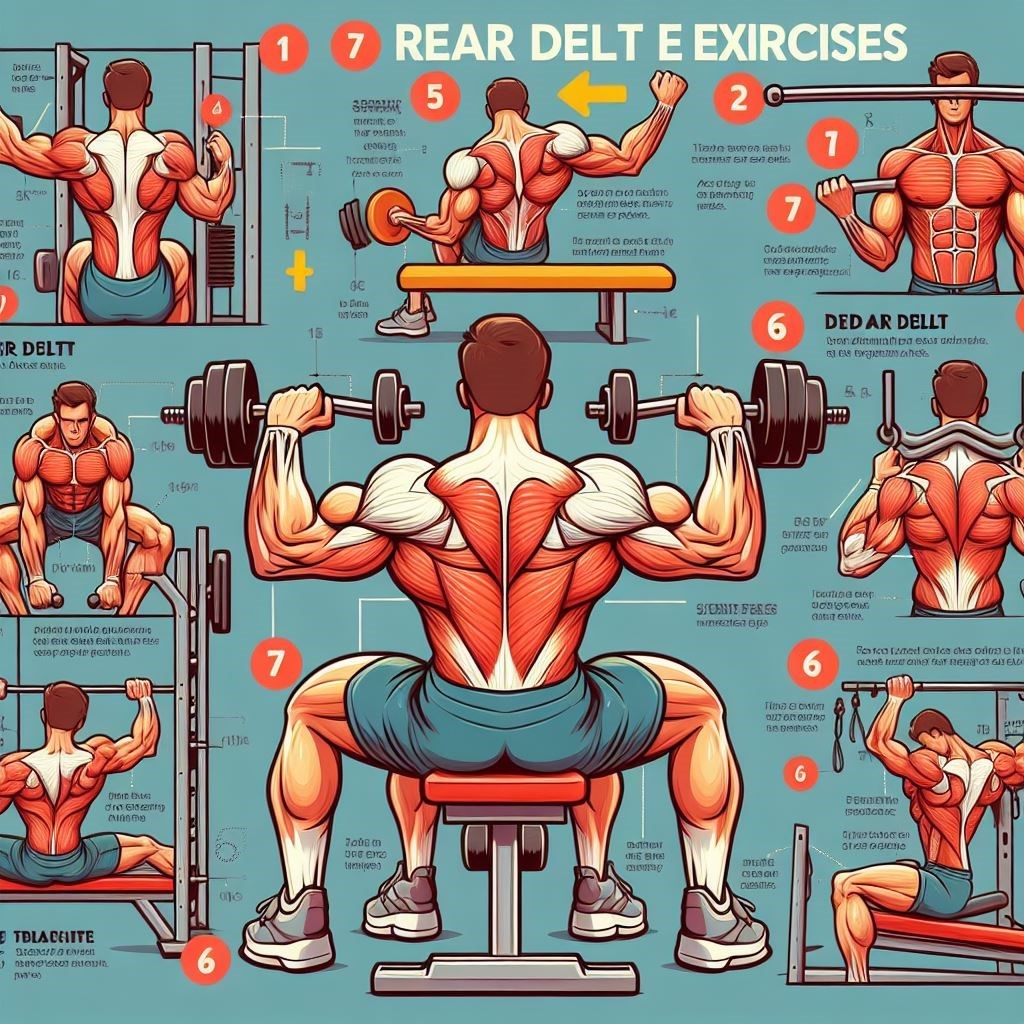
Before getting to the exercises, here are the key points to remember:
- For optimal outcomes, incorporate rear deltoid training into your routine two to three times weekly.
- Use a combination of compound and isolation movements.
- Emphasize a full range of motion with form.
- Optimal muscle growth is stimulated by utilizing a moderate weight and completing 8-12 repetitions..
- Squeeze and hold contractions to maximize time under tension.
- Allow 48 hours of rest between intense Rear Delt exercises sessions.
- Warm up properly and start with lighter weights.
Top 15 Rear Delt Exercises
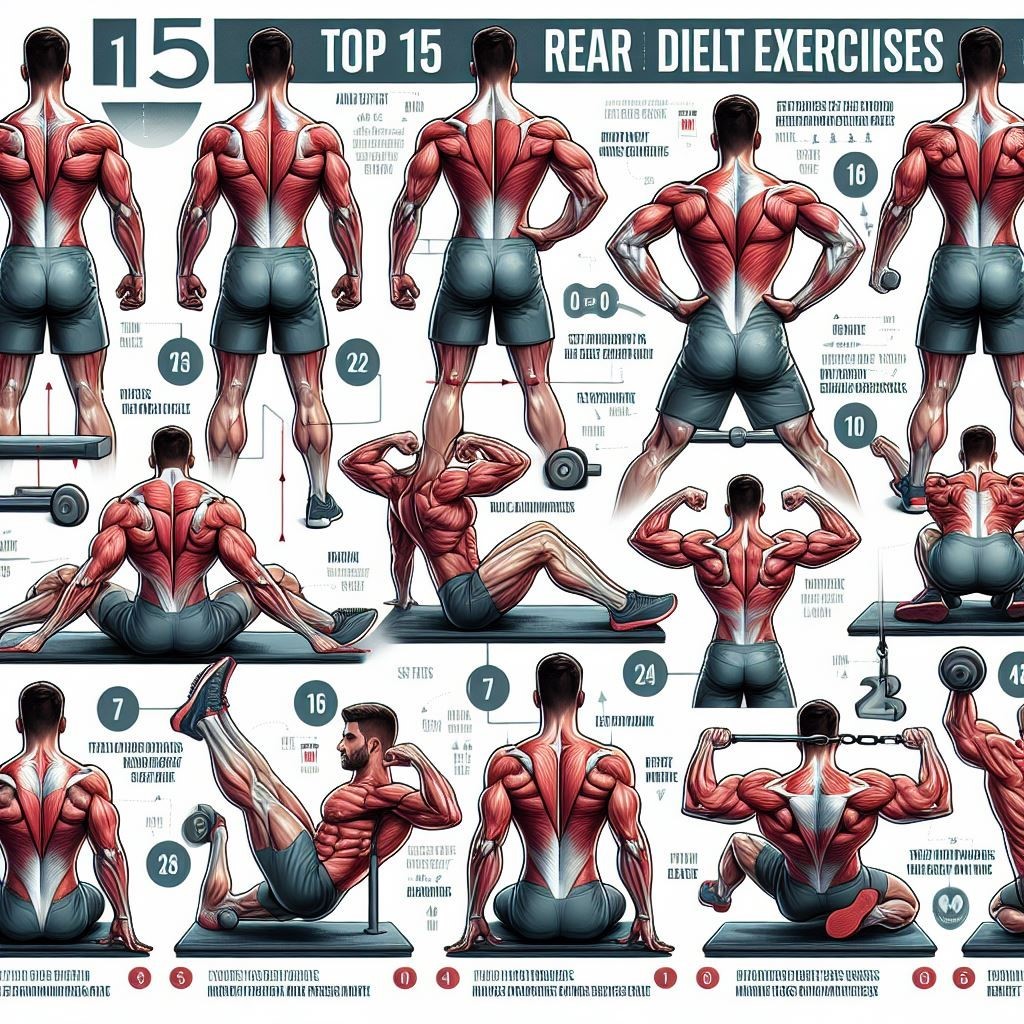
Now let’s check out the top 15 Rear delt exercises options for building your rear delts!
-
Bent-over posterior deltoid fly exercise

Bent over rear delt fly is the best Rear Delt Exercises. This classic movie isolates the rear delts using dumbbells. The bent position provides constant tension.
Instructions for executing the bent-over rear deltoid fly:
- Hold dumbbells and hinge at hips with a flat back.
- Let arms hang straight down perpendicular to the floor.
- Initiate the fly by raising your arms out to the sides.
- Bring dumbbells together overhead in an inverted V.
- Gradually return to the initial stance.,
Form tips for the bent-over rear delt fly:
- Maintain a flat back; do not round the spine.
- Keep a slight bend in your knees throughout.
- Lift arms to align with torso; do not go past parallel.
- Slowly lower dumbbells under control
- Squeeze rear delts at the top.
Strive for 2-3 sets with 10-12 repetitions each. Ensure the weight is sufficiently demanding to exhaust the posterior deltoids.
.Seated Rear Delt Fly is the best Rear Delt Exercises

This machine isolation exercise targets the rear delts through a comfortably seated position.
How to perform the seated rear delt fly:
- Sit upright and grasp machine handles.
- Keep arms straight and palms facing each other.
- • Commence the fly exercise by contracting the shoulder blades together.
- Elevate the handles outward, extending arms until they align parallel to the ground.,
- Slowly return to the starting position
Form tips for the seated rear delt fly:
- Maintain an upright posture; do not slouch.
- Limit front delt involvement by keeping arms straight.
- Do not swing or use momentum on the fly-out.
- Pause and squeeze rear delts at the peak contraction.
- Use a full range of motion on each rep.
Aim for higher reps like 3 sets of 12-15 to build muscle endurance. Go slowly and focus on technique.
-
Rear Delt Cable Fly

Rear Delt Cable fly is the best Rear Delt Exercises.
Cables maintain consistent tension on the posterior deltoids throughout the entire range of movement. This makes them an excellent choice for accessory work.
How to perform the rear delt cable fly:
- Attach D-handles to the cable and stand with a split stance.
- Arms start extended in front of thighs with palms facing each other.
- Initiate fly by driving arms back and out to sides.
- Bring handles together so forearms touch at full contraction.
- Slowly return to the starting position.
Form tips for the rear delt cable fly:
- Maintain a flat back; do not arch or round.
- Keep elbows slightly bent; do not lock.
- Drive your arms back as far as comfortable; do not strain.
- Squeeze shoulder blades at peak contraction.
- Control both concentric and eccentric.
Shoot for higher reps (12-15) with lighter weight to thoroughly fatigue the rear delts.
-
Reverse Pec Deck Fly for Rear Delt Exercises

The reverse pec deck provides constant tension on the rear delts for top-tier isolation. This machine targets them specifically.
How to perform the reverse pec deck fly:
- Sit upright with your back pressed against the pad.
- Grip handles and keep arms straight in front of the chest.
- Commence the fly movement by contracting the shoulder blades in unison.
- Bring handles back until elbows touch.
- Slowly return to the starting position.
Form tips for the reverse pec deck fly:
- Sit tall and do not slouch during the set.
- Keep your chest pressed against the pad throughout.
- Bring elbows together at peak contraction.
- Use the controlled form, no swinging.
- Go through a full range of motion.
Execute 2-3 sets with 10-12 repetitions, emphasizing the contraction of the posterior deltoids at the rear of each repetition.
-
The Rear Delt Row is the top of the Rear Delt Exercises

This free-weight exercise recruits the rear delts using dumbbells through shoulder extension and retraction.
Instructions for executing the row targeting the rear deltoid:
- Hold dumbbells with an overhand grip.
- Hinge at hips and bend knees slightly
- Keeping back flat, row dumbbells up toward hips
- Lead with elbows, squeezing shoulder blades.
- Gently return the weights to their initial position..
Form tips for the rear delt row:
- Maintain a flat back; do not round.
- Row to hip level; do not go higher.
- Keep shoulders retracted; avoid elevation.
- Focus on squeezing the shoulder blades together.
- Control the descent; no dropping weights.
Shoot for 2-3 sets of 10-12 controlled reps to hit those rear delts!
-
Face Pull as one of the Rear Delt Exercises

This cable exercise targets the rear delts through shoulder retraction and external rotation. Use lighter weights and higher reps.
How to perform the face pull:
- Attach a rope handle to the cable pulley.
- Stand sideways, gripping the rope in front of the face.
- Initiates pull by drawing rope back toward ears.
- Lead with elbows and externally rotate shoulders
- Return slowly to the starting position.
Form tips for the face pull:
- Maintain an upright posture; do not lean or hunch.
- Keep elbows at or above shoulder level.
- Squeeze shoulder blades at peak contraction.
- Avoid arching the lower back; engage the core.
- Control the return by resisting the cable.
Aim for 3 sets of 12-15 reps. Squeeze those rear delts!
-
External Rotation Rear Delt Exercises

This isolation exercise uses cables or bands to target the rear delts through an external rotation movement.
How to perform the external rotation
- Stand sideways, holding band/cable attachment.
- Keeping the elbow bent 90 degrees, rotate the arm out to the side.
- Bring the arm out until the hand aligns with the torso.
- Slowly return to the starting position.
Form tips for the external rotation:
- Keep your elbow fixed at the side; do not allow drifting.
- Maintain an upright posture.
- Rotate until the hand aligns with the mid-back.
- Control both concentric and eccentric.
- Only rotate at the shoulder; keep the body still.
Perform 2-3 sets of 15-20 reps per side, focusing on technique and contraction.
-
Incline Y Raise
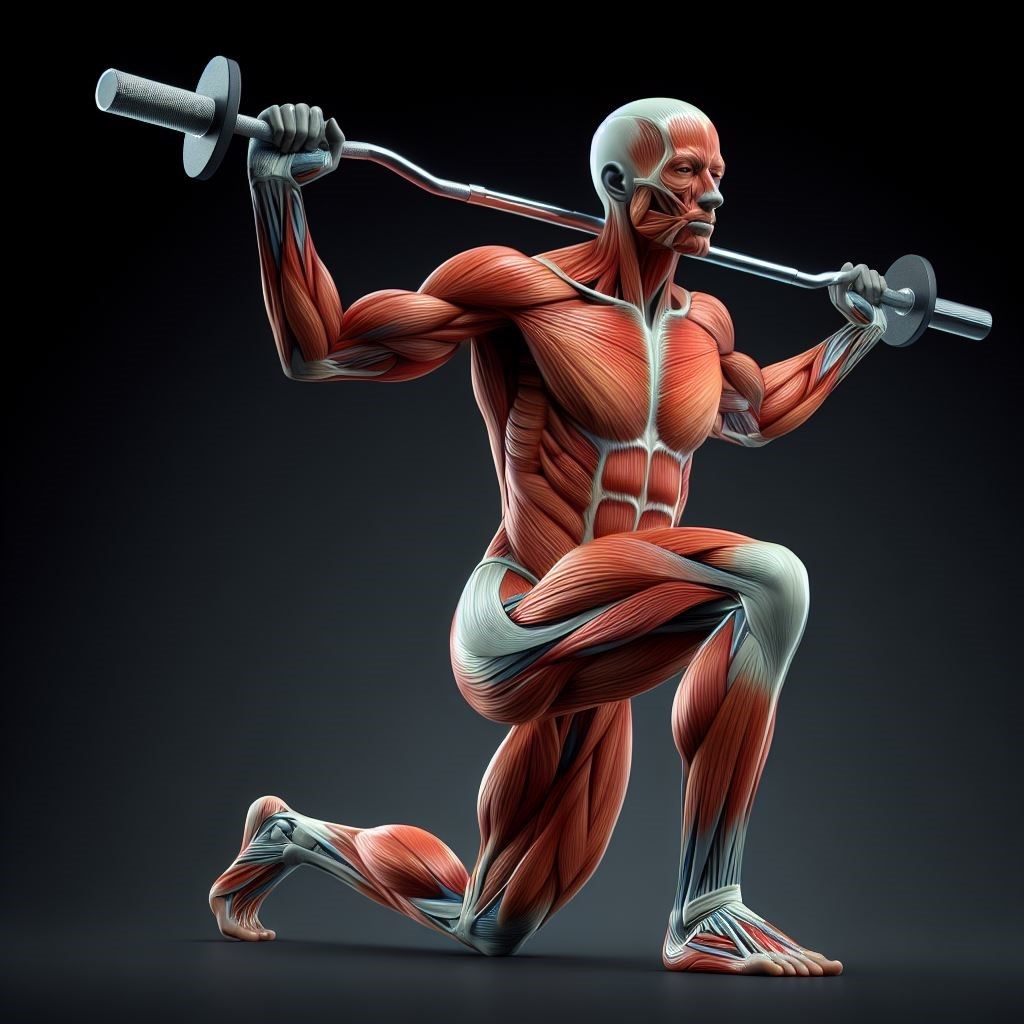
The incline Y raise targets the rear delts dynamically through shoulder retraction and elevation. Use lighter dumbbells.
How to perform the incline Y raise:
- Lie chest down on an incline bench set to 30-45 degrees.
- Hold dumbbells with arms extended straight down.
- Raise arms in a Y shape, leading with thumbs.
- Bring dumbbells together overhead, squeezing shoulder blades.
- Slowly lower my arms back to the starting position.
Form tips for the incline Y raise:
- Maintain a straight line from head to heels.
- Do not arch your lower back; keep your core braced.
- Bring dumbbells slightly behind the head at the top.
- Control descent; no dropping weights
- Palm face each other throughout the movement.
Shoot for 2-3 sets of 12-15 reps focusing on good form.
-
Band Pull Apart Rear Delt Exercises

Resistance bands make this exercise accessible anywhere to hit those rear delts! Emphasize contraction.
How to perform the band pull apart:
- Stand in the center of the band with feet hip-width apart.
- Grasp the band with palms facing forward.
- Pull the band apart by squeezing the shoulder blades together.
- Bring elbows out to sides until hands align with shoulders
- Slowly return the band to the starting position
Form tips for the band pull apart:
- Maintain an upright posture; do not hunch
- Keep tension in the band at all times
- Focus on squeezing shoulder blades together
- Limit front delt involvement
- Control the return; do not release the band
Perform 2-3 sets of 15-20 reps. Focus on muscle contraction rather than weight movement.
-
Low Trap Raise Rear Delt Exercises
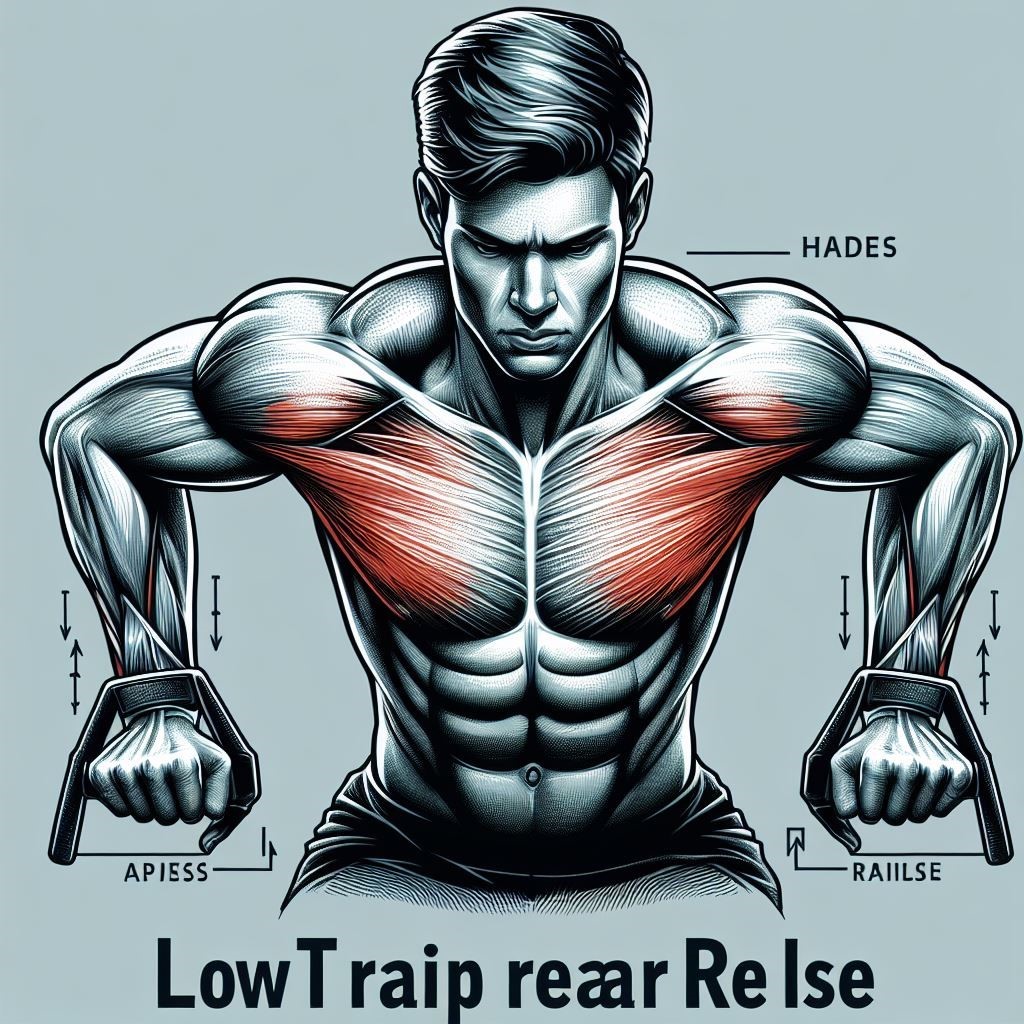
Hit the lower traps by raising the shoulder blades upward while lying face down. Use lighter dumbbells.
How to perform the low trap raise:
- Lie on your chest with arms extended overhead
- Retract shoulder blades down and together
- Initiate raise by lifting shoulder blades toward the ceiling
- Raise as high as possible before slowly lowering
Form tips for the low trap raise:
- Maintain a flat back; do not hyperextend
- Avoid lifting your chest off the floor
- Raise shoulder blades as high as possible
- Slowly lower under control
- Squeeze low traps at the top
Do 2-3 sets of 15-20 controlled reps, squeezing at the top.
-
Band Face Pull Rear Delt Exercises

Band face pulls provide constant tension on the rear delts. The external rotation targets them specifically.
How to perform the band face pull:
- Attach the band at head level and grasp handles.
- Stand with arms extended straight out.
- Initiates pull by drawing elbows back and rotating shoulders.
- Bring hands back toward ears, squeezing shoulder blades.
- Return slowly to the starting position.
Form tips for the band face pull:
- Maintain an upright posture; do not hunch.
- Always keep tension in the band.
- Lead with the elbows; do not pull with arms.
- Bring elbows back as far as comfortable.
- Control, return and resist band tension
Perform 2-3 sets of 12-15 reps with a slow, controlled tempo.
-
Seated Machine Face Pull
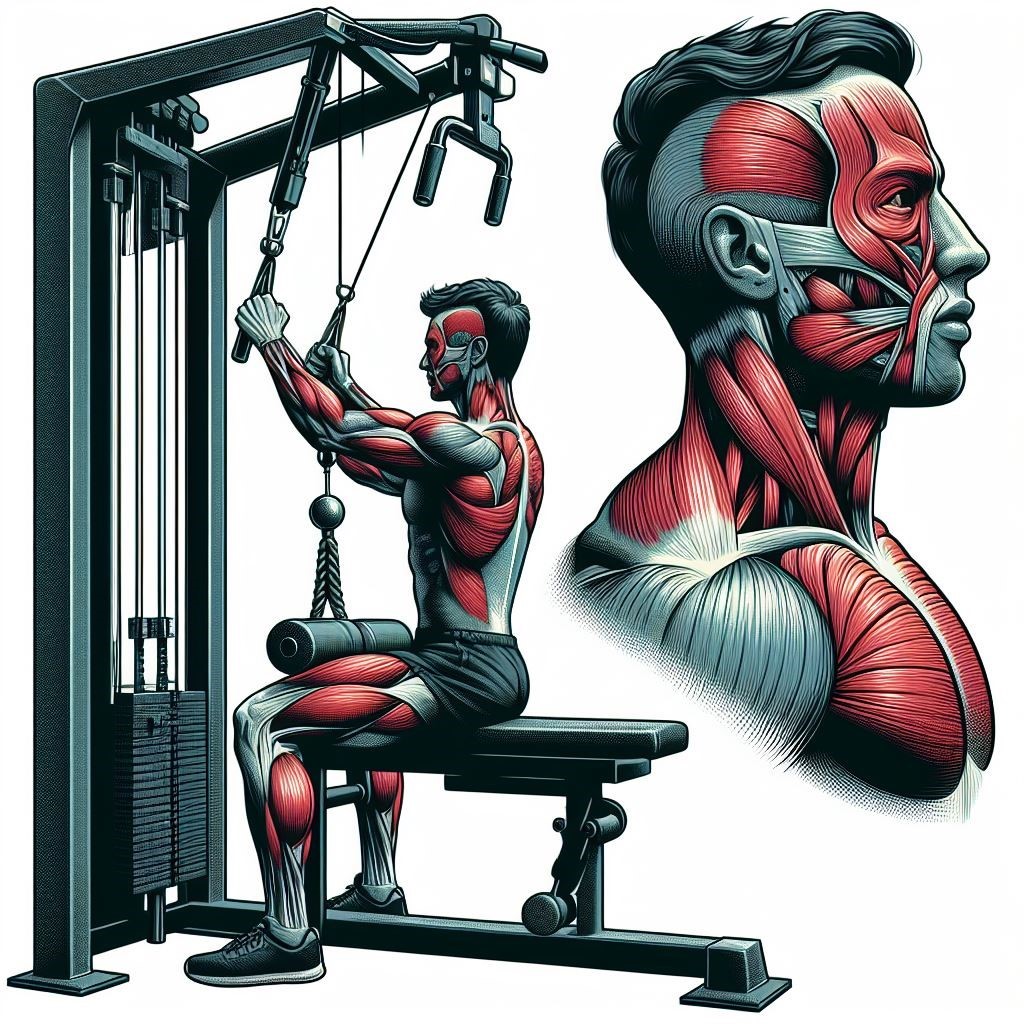
The machine version allows you to isolate those rear delts through a seated external rotation movement.
How to perform the seated machine face pull:
- Sit upright in the machine with thighs underpass.
- Grasp handles with palms down and arms extended.
- Initiates pull by driving elbows back and up.
- Lead with elbows until handles align with ears.
- Slowly return arms to the starting position
Form tips for the seated machine face pull:
- Sit tall; do not slouch during the set.
- Avoid leaning or rotating the torso.
- Bring elbows as far back as comfortably possible.
- Control the return by resisting the weight.
- Go through a full range of motion.
Aim for higher reps like 3 sets of 12-15 for successful rear delt isolation.
-
Bent Over Lateral Raise
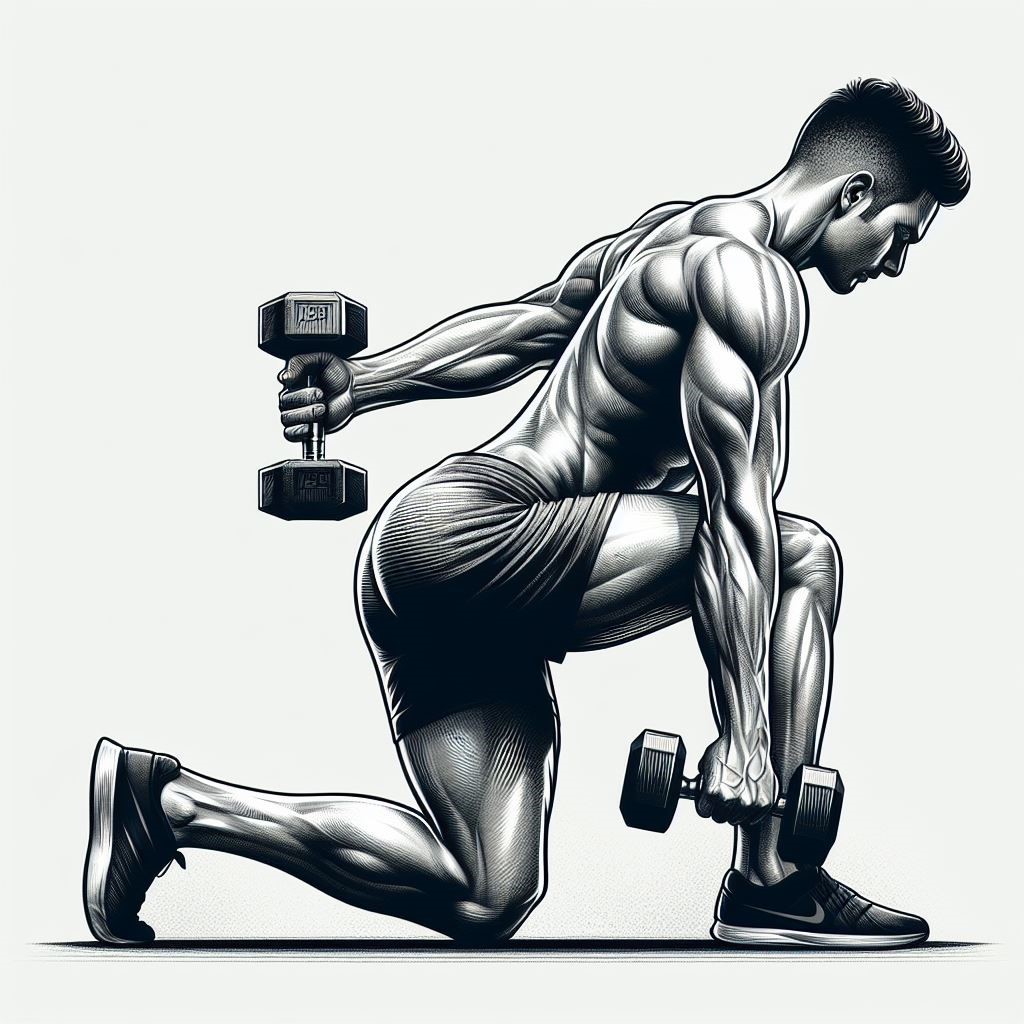
This isolation exercise hits the rear delts unilaterally with dumbbells. Maintain a slight hinge at the hips.
How to perform the bent-over lateral raise
- Hold a dumbbell in one hand and hinge at the hips.
- Bend the supporting arm 90 degrees; straighten the working arm.
- Raise the working arm straight out to the side until parallel with the torso.
- Slowly lower the dumbbell back to the starting position.
Form tips for the bent-over lateral raise:
- Maintain a flat back; do not excessively round.
- Position the body to allow straight arm raising.
- Raise the arm just until parallel with the body.
- Slowly lower the dumbbell under control.
- Keep shoulder blades retracted and down.
Perform 2-3 sets of 10-12 controlled reps per side. Fatigue, those rear delts!
-
Reverse Fly as one of the Rear Delt Exercises

Step into the machine and grab the handles to target those rear delts through horizontal shoulder extension.
How to perform the reverse fly:
- Adjust pads to fit the torso and stand upright.
- Grasp handles with arms extended in front of the chest.
- Initiating fly by squeezing shoulder blades together
- Bring hands outward until elbows are behind shoulders.
- Slowly return the handles to the starting position
Form tips for the reverse fly:
- Maintain an upright posture; do not lean or slouch.
- Keep constant tension on rear delts throughout
- Bring elbows only as far back as comfortable.
- Control the return to the starting position.
- Use a full range of motion through the shoulders.
Aim for 2-3 sets of 10-12 reps with perfect technique.
-
Bent Over Dumbbell Raise for Rear Delt Exercises

Finish off your rear delts by bending over and raising dumbbells on the side of your body.
How to perform the bent-over dumbbell raise:
- Hold dumbbells and hinge over at hips.
- Let your arms hang directly downward, forming a right angle with the floor.
- Lift your arms directly to the sides until they align parallel to your torso.
- Gradually descend back to the initial position.
Form tips for the bent-over dumbbell raise:
- Maintain a flat back; do not excessively round.
- Raise dumbbells just until parallel with the torso.
- Slowly lower weights under control
- Keep shoulders retracted; avoid elevation.
- Palms face each other throughout.
Perform 2-3 sets of 10-12 reps. Focus on squeezing those rear delts!
Guidance on Enhancing the Strength of Your Rear Delts Exercises
Enhancing Rear Delt Strength
The rear delts play a crucial role in shoulder health and posture, yet they are often neglected. Here are some tips for strengthening your rear delts:
Focus on Compound Exercises
Multi-joint exercises like rows, face pulls, and band pull-apart engage the rear delts isometrically. Make these compound moves the foundation of your rear delt training.
Emphasize Eccentric Training
An exercise’s eccentric or lowering phase provides the most muscle damage and strength gains. Slow down the eccentric portion of rear delt exercises.
Use Challenging Weights
Lift weights that fatigue your rear delts in the 8-12 rep range. When 12 reps become easy, increase the weight. Progressive overload is key.
Angle Your Torso
Exercises like reverse flies allow you to angle your torso to increase rear delt activation. Experiment with different angles.
Change Hand Position
Using a pronated (overhand) vs. neutral grip affects rear delt recruitment. Alternate grips for variety.
Try Unilateral Training
Single arm rear delt exercises improve weak side deficits and core stability. Dumbbells and cables allow for unilateral work.
Get a Pump
Include high rep rear delt “burn out” sets at the end of workouts when blood flow is maximized. Shoot for 15-20 reps.
Check Your Posture
Poor posture reduces rear delt engagement. Retract your shoulders and maintain an upright position when training.
Be Patient
Rear delts contain a high proportion of slow-twitch fibres. Results come slower than other muscle groups. Stick with it. You will enhance your upper body posture, strength, and muscular balance with focused, progressive rear delt training.
Wrap-up
There are 15 outstanding exercises to train your rear delts and take your shoulders to the next level! Remember, these tips:
- Train Rear Delt Exercises 2-3 times per week for maximum growth.
- Use a mix of compounds and isolation exercises.
- Go through a full range of motion with each rep.
- Moderate weight and 8-12 reps build muscle.
- Allow at least 1 day of rest between intense sessions.
- Warm up properly and begin with lighter weights.
You can bring up those rear delts exercises with dedication and proper programming and get that coveted V-taper and rounder shoulder look. Now get to it!



